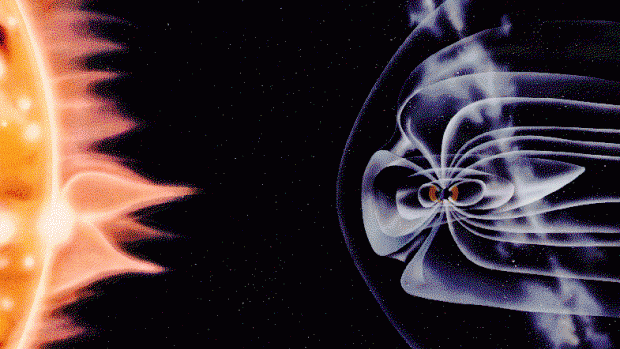
The magnetosphere is the region of space surrounding Earth where the dominant magnetic field is the magnetic field of Earth, rather than the magnetic field of interplanetary space. The magnetosphere is formed by the interaction of the solar wind with Earth’s magnetic field. This figure illustrates the shape and size of Earth’s magnetic field that is continually changing as it is buffeted by the solar wind.
It has been several thousand years since the Chinese discovered that certain magnetic minerals, called lodestones, would align in roughly the north-south direction. The reason for this effect wasn’t understood, though, until 1600, when William Gilbert published De Magnete and demonstrated that our Earth behaved like a giant magnet and loadstones were aligning with Earth’s magnetic field.
After several more centuries of investigation, it is now known that Earth’s magnetic field is quite complex, but still, to a great extent, can be viewed as a dipole, with north and south poles like a simple bar magnet. Earth’s magnetic axis, the dipole, is inclined at about 11 degrees to Earth’s spin axis. If space were a vacuum, Earth’s magnetic field would extend to infinity, getting weaker with distance, but in 1951, while studying why comet tails always point away from the sun, Ludwig Biermann discovered that the sun emits what we now call the solar wind. This continuous flow of plasma, comprised of mostly electrons and protons, with an embedded magnetic field, interacts with Earth and other objects in the solar system.
The pressure of the solar wind on Earth’s magnetic field compresses the field on the dayside of Earth and stretches the field into a long tail on the nightside. The shape of the resulting distorted field has been compared to the appearance of water flowing around a rock in a stream. On the dayside of Earth, rather than extending to infinity, the magnetic field is confined to within about 10 Earth radii from the center of Earth and on the nightside, the field is stretched out to hundreds of Earth radii, well beyond the orbit of the moon at 60 Earth radii.
The boundary between the solar wind and Earth’s magnetic field is called the magnetopause. The boundary is constantly in motion as Earth is buffeted by the ever-changing solar wind. While the magnetopause shields us to some extent from the solar wind, it is far from impenetrable, and energy, mass, and momentum are transferred from the solar wind to regions inside Earth’s magnetosphere. The interaction between the solar wind and Earth’s magnetic field, and the influence of the underlying atmosphere and ionosphere, creates various regions of fields, plasmas, and currents inside the magnetosphere such as the plasmasphere, the ring current, and radiation belts. The consequence is that conditions inside the magnetosphere are highly dynamic and create what we call “space weather” that can affect technological systems and human activities. For example, the radiation belts can have impacts on the operations of satellites, and particles and currents from the magnetosphere can heat the upper atmosphere and result in satellite drag that can affect the orbits of low-altitude Earth orbiting satellites. Influences from the magnetosphere on the ionosphere can also affect communication and navigations systems. All of these effects are discussed elsewhere in more detail.